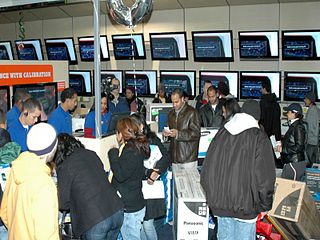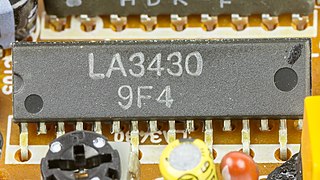![FMX Logo [1] FMX logo.svg](http://upload.wikimedia.org/wikipedia/commons/thumb/2/29/FMX_logo.svg/220px-FMX_logo.svg.png)
FMX is the name of a commercially unsuccessful noise reduction system developed in the 1980s for FM broadcasting in the United States.
Noise reduction is the process of removing noise from a signal.

FM broadcasting is a method of radio broadcasting using frequency modulation (FM) technology. Invented in 1933 by American engineer Edwin Armstrong, wide-band FM is used worldwide to provide high-fidelity sound over broadcast radio. FM broadcasting is capable of better sound quality than AM broadcasting, the chief competing radio broadcasting technology, so it is used for most music broadcasts. Theoretically wideband AM can offer equally good sound quality, provided the reception conditions are ideal. FM radio stations use the VHF frequencies. The term "FM band" describes the frequency band in a given country which is dedicated to FM broadcasting.
FM stereo broadcasting is known to incur up to a 23 dB noise penalty over that of monophonic FM broadcasting; this is due to the combination of the triangular FM noise spectrum and the wider baseband bandwidth occupied by the stereo multiplex signal. Developed at the CBS Technology Center, FMX was intended to improve this characteristic for listeners in the fringe areas where the noise penalty would be worst. This improvement was achieved by adding an amplitude-compressed version of the L−R (left-minus-right, or difference) signal modulated in quadrature with the stereo subcarrier, using a version of the CX noise-reduction system originally developed at CBS for LP records.
The decibel is a unit of measurement used to express the ratio of one value of a power or field quantity to another on a logarithmic scale, the logarithmic quantity being called the power level or field level, respectively. It can be used to express a change in value or an absolute value. In the latter case, it expresses the ratio of a value to a fixed reference value; when used in this way, a suffix that indicates the reference value is often appended to the decibel symbol. For example, if the reference value is 1 volt, then the suffix is "V", and if the reference value is one milliwatt, then the suffix is "m".

Monaural or monophonic sound reproduction is sound intended to be heard as if it were emanating from one position. This contrasts with stereophonic sound or stereo, which uses two separate audio channels to reproduce sound from two microphones on the right and left side, which is reproduced with two separate loudspeakers to give a sense of the direction of sound sources. In mono, only one loudspeaker is necessary, but, when played through multiple loudspeakers or headphones, identical signals are fed to each speaker, resulting in the perception of one-channel sound "imaging" in one sonic space between the speakers. Monaural recordings, like stereo ones, typically use multiple microphones fed into multiple channels on a recording console, but each channel is "panned" to the center. In the final stage, the various center-panned signal paths are usually mixed down to two identical tracks, which, because they are identical, are perceived upon playback as representing a single unified signal at a single place in the soundstage. In some cases, multitrack sources are mixed to a one-track tape, thus becoming one signal. In the mastering stage, particularly in the days of mono records, the one- or two-track mono master tape was then transferred to a one-track lathe intended to be used in the pressing of a monophonic record. Today, however, monaural recordings are usually mastered to be played on stereo and multi-track formats, yet retain their center-panned mono soundstage characteristics.

In telecommunications and signal processing, frequency modulation (FM) is the encoding of information in a carrier wave by varying the instantaneous frequency of the wave.
Upon his accession as Chairman of CBS, Laurence Tisch closed the CBS labs in 1986, whereupon the FMX intellectual property was spun off to an investment group, under the name Broadcast Technology Partners (BTP).
Laurence Alan "Larry" Tisch was an American businessman, Wall Street investor and billionaire. He was the CEO of CBS television network from 1986 to 1995. With his brother Bob Tisch, he was part owner of the Loews Corporation.
Intellectual property (IP) is a category of property that includes intangible creations of the human intellect. Intellectual property encompasses two types of rights; industrial property rights and copyright. It was not until the 19th century that the term "intellectual property" began to be used, and not until the late 20th century that it became commonplace in the majority of the world.
With about 50 stations using the technology and perhaps another 50 committed, a controversy emerged in 1989 when MIT professor and Bose Corporation CEO Amar Bose and Bose engineer William Short released a critical study, finding the system to have the potential to "seriously degrade the quality of stereo reception whether received by FMX equipment or not." According to the study, the heavy compression of the L−R audio caused interference in receivers under multipath conditions. A BTP spokesman rebutted the finding, saying that the Bose analysis exaggerated a "worst-case scenario", and actually employed "flawed mathematics" to attempt to prove their point. Perhaps not coincidentally, a patent application filed earlier by Bose [2] disclosed an invention whose implementation was incompatible with the adoption of FMX, while another – filed by Bose and Short around the time of the release of the critical study – sought to improve the performance of FMX under multipath conditions. [3]
Bose Corporation is a privately held American corporation, based in Framingham, Massachusetts, that designs, develops and sells audio equipment. Founded in 1964 by Amar Bose, the company sells its products throughout the world. According to the company annual report in the 2017 financial year, Bose received revenue of US$3.8 billion and employed more than 8,000 people. Bose is best known for its home audio systems and speakers, noise cancelling headphones, professional audio systems and automobile sound systems. The company has also conducted research into suspension technologies for cars and heavy-duty trucks and into the subject of cold fusion. Bose has a reputation for being particularly protective of its patents, trademarks, and brands.

Amar Gopal Bose, was an American academic and entrepreneur. An electrical engineer and sound engineer, he was a professor at the Massachusetts Institute of Technology (MIT) for over 45 years. He was also the founder and chairman of Bose Corporation. In 2011, he donated a majority of the company to MIT in the form of non-voting shares to sustain and advance MIT's education and research mission.
In electronic communications, especially in telecommunications, an interference is that which modifies a signal in a disruptive manner, as it travels along a channel between its source and receiver. The term is often used to refer to the addition of unwanted signals to a useful signal. Common examples are:
Despite industrial supporters in both the broadcast and consumer electronics industries, the system never achieved a critical mass, and faded into obscurity. However, numerous related patents have since been applied for or granted, referencing the original FMX patents. [4]

Consumer electronics or home electronics are electronic equipments intended for everyday use, typically in private homes. Consumer electronics include devices used for entertainment, communications, and home-office activities. In British English, they are often called brown goods by producers and sellers, to distinguish them from "white goods" which are meant for housekeeping tasks, such as washing machines and refrigerators, although nowadays, these would be considered brown goods, some of these being connected to the Internet. In the 2010s, this distinction is not always present in large big box consumer electronics stores, such as Best Buy, which sell both entertainment, communication, and home office devices and kitchen appliances such as refrigerators.






